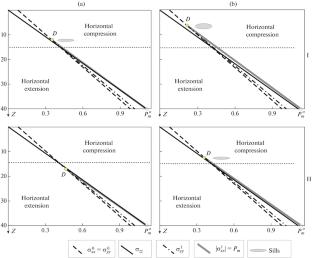On Generation Mechanisms of Excessive Horizontal Compression in Continental Crust
Abstract—It is proposed to consider the processes of surface denudation and magmatism in the Earth’s crust to explain the formation in it of elevated horizontal compressive stresses in excess of lithostatic pressure. Rock exhumation only partially unloads the crust due by removing the weight of the overburden if the crust at depth was above the yield point. This is due to the fact that in the case of exhumation, the unloading occurs elastically. As a result, residual horizontal compressive stresses acquired at the stage of supercritical cataclastic flow arise in the rock. Another mechanism to account for the formation of additional compressive stresses in the crust involves volcanic and magmatic processes. Magma ascent along subvertical crustal faults and networks of fractures is only possible if magma pressure at the propagation front is above the level of horizontal compression in the rock. The result is that below the magma propagation front, the level of horizontal compressive stresses in the rocks rises to the level of magma pressure. Because the pressure in the subcrustal or intracrustal magma chamber is close to the lithostatic pressure of the overburden, fault-orthogonal stresses above the magma propagation front in the fault exceed the level of vertical compression. Thus, crustal magmatization is capable of changing the crustal stress state from horizontal extension to horizontal shear.


 求助内容:
求助内容: 应助结果提醒方式:
应助结果提醒方式:


